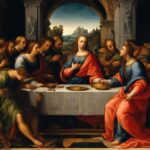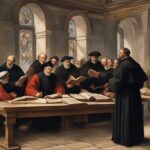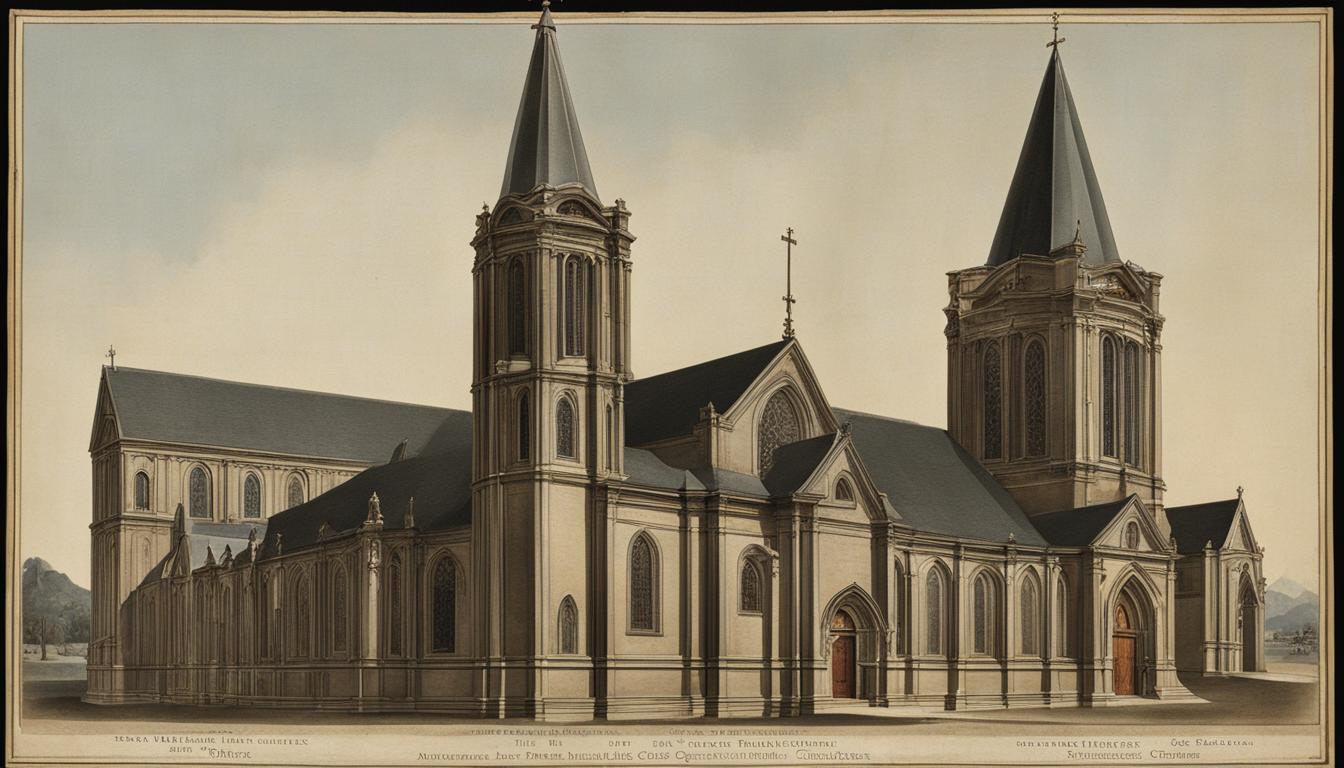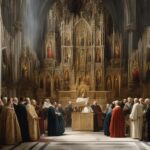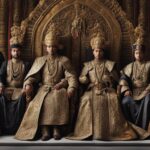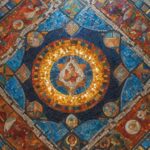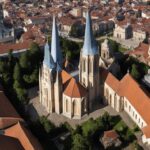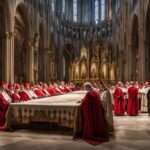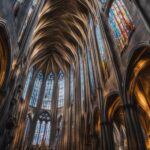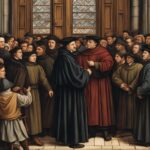The Renaissance, spanning the 14th to 17th centuries, was a time of cultural, intellectual, and scientific advancements. It was also marked by political and religious freedoms, influenced by the English Reformation and the Humanism movement. The influence of religion on Renaissance art was profound, shaping its themes, symbolism, and subjects.
Key Takeaways
- Religion played a significant role in shaping the themes and subjects of Renaissance art.
- Renaissance paintings often depicted religious figures and conveyed theological messages.
- Religious symbolism and allegory added depth and meaning to Renaissance artworks.
- Depictions of Madonna and Christ were a prominent theme in Renaissance art.
- Religious art impacted society by inspiring devotion and bridging the gap between the divine and the human.
The Role of Religion in Renaissance Paintings
Renaissance paintings were not only artistic masterpieces but also reflections of religious influence. Artists of this period found inspiration in religious figures and narratives, using their skills to portray important moments in biblical stories. These paintings served as visual representations of theological messages, capturing the essence of religious figures and bringing religious narratives to life. Through their artwork, artists aimed to inspire devotion, deepen the connection with religion, and evoke religious feelings in the viewers.
“Artists used their skills to render biblical stories and capture the essence of religious figures.”
One example of the role of religion in Renaissance paintings is Michelangelo’s “Creation of Adam” on the ceiling of the Sistine Chapel. This iconic painting depicts the biblical narrative of God breathing life into Adam, visually translating a significant moment in religious history. Another notable painting is Leonardo da Vinci’s “The Last Supper,” which portrays the moment when Christ reveals the betrayal of one of his disciples. These artworks not only showcased the artistic talent of the Renaissance but also aimed to inspire contemplation and devotion among the viewers.
“These paintings aimed to inspire devotion and deepen the viewers’ connection with religion.”
| Artwork | Artist | Description |
|---|---|---|
| Mona Lisa | Leonardo da Vinci | A masterpiece that reflects the blending of religious themes and human emotion, depicting Madonna and Child. |
| The Birth of Venus | Sandro Botticelli | Depicts the birth of Venus, the Roman goddess of love, using religious symbolism and classical mythology. |
| The School of Athens | Raphael | Features a gathering of philosophers and scholars, representing the harmonious blending of Greek philosophy and Christian theology. |
Religious influence in Renaissance paintings reached beyond the portrayal of religious narratives. Artists also utilized religious symbolism to convey hidden meanings and spiritual depths. The halo, a luminous aura surrounding the heads of saints, symbolized divine enlightenment and holiness. Artists used halos to elevate the subjects and demonstrate their godly nature. Other symbols, such as the lamb representing the sacrificial role of Christ, added layers of meaning to the artworks. These symbols and allegories allowed artists to create a visual language that resonated with the viewers and deepened their contemplation of spiritual and religious themes.
“Artists utilized religious symbolism to convey hidden meanings and spiritual depths.”
In conclusion, the role of religion in Renaissance paintings was significant. Artists of this period found inspiration in religious figures and narratives, using their artistic skills to portray the essence of religious stories. These paintings aimed to inspire devotion, deepen the connection with religion, and evoke religious feelings in the viewers. Religious symbolism and allegory added spiritual depth and layers of meaning to the artworks. The influence of religion in Renaissance paintings continues to resonate in the appreciation and interpretation of these masterpieces, demonstrating the enduring impact of faith on artistic expression.
Religious Symbolism in Renaissance Art
The Renaissance period witnessed a significant interplay between religion and art, with religious symbolism becoming a prominent feature of artworks. Artists of the time utilized symbols to convey hidden meanings and evoke spiritual depths in their works. These symbols served as visual language, capable of resonating with viewers and leading them to contemplate spiritual and religious themes.
One of the most recognizable religious symbols in Renaissance art is the halo, a luminous aura often depicted above the heads of saints. The halo symbolized divine enlightenment and holiness, elevating the subjects and emphasizing their godly nature. By incorporating such symbols, artists aimed to create a connection between the earthly realm and the divine, provoking deeper reflection and devotion from the viewers.
“The halo symbolized divine enlightenment and holiness, elevating the subjects and emphasizing their godly nature.”
Allegory also played a significant role in religious art of the Renaissance. Artists used allegorical narratives and objects to represent deeper concepts and moral lessons. For example, the depiction of a lamb symbolized the sacrificial role of Christ, while the inclusion of skulls, hourglasses, and vanitas symbols in still-life paintings reminded viewers of the transient nature of life and the importance of contemplating spiritual matters.
The use of religious symbolism and allegory in Renaissance art created a rich tapestry of meaning and invoked a sense of spiritual contemplation among viewers. These symbols transcended the canvas, allowing art to become a medium through which individuals could engage with deeper spiritual and religious themes.
![]()
Madonna and Christ in Renaissance Art
Renaissance art prominently featured the representation of Madonna (the Virgin Mary) and Christ, capturing the duality of religious meaning and human emotion. Artists sought to depict Madonna as a loving and tender mother, invoking a sense of devotion and inspiring religious sentiments among viewers. The paintings showcased Madonna’s maternal role, emphasizing her beauty and idealized motherhood. Artists such as Raphael and Botticelli created iconic images that symbolized spirituality and compassion, serving as focal points for prayers and reflections.
The depiction of Madonna and Christ in Renaissance art bridged the gap between the divine and the human, elevating this sacred relationship to a significant aspect of religious devotion. The paintings aimed to connect believers with the divine through the portrayal of the loving bond between mother and child. These artworks provided a focal point for religious contemplation and intercession, allowing viewers to immerse themselves in the deep spiritual meaning behind the imagery.
The depiction of Madonna and Christ in Renaissance art not only inspired religious devotion but also showcased the artistic skill of the period. Artists paid meticulous attention to detail, capturing the expressions, gestures, and drapery in a naturalistic and humanistic manner. This attention to detail allowed viewers to relate to the subjects and perceive their relevance in everyday life. Renaissance artists sought to evoke a sense of connection and awe, emphasizing the virtues and attributes of the religious figures in their portraits. Through these representations, artists aimed to inspire viewers to aspire to a higher level of devotion and holiness.
Religious Portraiture in the Renaissance
Religious portraiture was a notable strand in the fabric of Christian imagery during the Renaissance. Artists paid attention to detail, capturing the spiritual power and holiness of saints in their portraits. These portraits aimed to inspire religious devotion and evoke a sense of connection with the subjects. The subjects were depicted in a naturalistic and humanistic manner, allowing viewers to relate to them and see the relevance of religious figures in everyday life. Artists like Luca di Tommè and Hans Baldung used various techniques, such as realistic facial expressions and attention to drapery, to bring the saints to life on the canvas. The portraiture emphasized the virtues and attributes of saints, encouraging viewers to aspire to their level of devotion and holiness.
| Artist | Famous Religious Portraits |
|---|---|
| Luca di Tommè | “Saint Catherine of Alexandria” |
| Hans Baldung | “The Virgin and Child” |
| Giovanni Bellini | “Portrait of Doge Leonardo Loredan” |
Religious portraiture during the Renaissance served as a powerful tool for religious education and spiritual connection. The detailed renderings of saints allowed viewers to understand and engage with their virtues and stories. Through these portraits, artists sought to inspire viewers to emulate the saints’ devotion and holiness in their own lives.
“The saints are living examples of the divine presence in our world, and by depicting their likeness, artists invite us to contemplate their virtues and strive to become more like them.” – Art historian, Dr. Elizabeth Smith
The Importance of Landscape in Religious Art
Landscape settings played a crucial role in religious art during the Renaissance. Artists strategically used naturalistic and relatable landscapes to enhance the relevance of religious icons to everyday life. By placing religious figures in familiar surroundings, such as rolling hills or serene lakes, artists aimed to create a stronger connection between the observer and the subjects portrayed. The inclusion of landscapes allowed viewers to envision themselves in the scenes with the religious icons, facilitating a deeper understanding and emotional involvement.
| Key Aspects | Explanation |
|---|---|
| Inclusivity | The use of landscapes brought religious narratives closer to the common people, making them relatable and inclusive. |
| Visual Appeal | Landscape settings added depth and dimension to paintings, creating a more immersive experience for the viewers. |
| Accessibility | By incorporating landscapes, Renaissance artists made religious themes more accessible and relatable to a wider audience. |
The significance of landscapes in religious art extended beyond aesthetics. These settings served to bridge the gap between the divine and the human, allowing viewers to connect with religious narratives on a personal and emotional level. The landscapes created a visual context that enhanced the religious themes and encouraged contemplation and reflection.
“By placing religious figures in relatable landscapes, Renaissance artists sought to bridge the gap between the divine and the human, making religious narratives more accessible and relatable to the viewers.”
- The use of landscapes in religious art facilitated a stronger emotional connection between the observer and the depicted religious figures.
- Landscape settings added depth and realism to paintings, creating a more immersive viewing experience.
- Artists strategically used landscapes to make religious narratives more accessible and relatable to a wider audience.
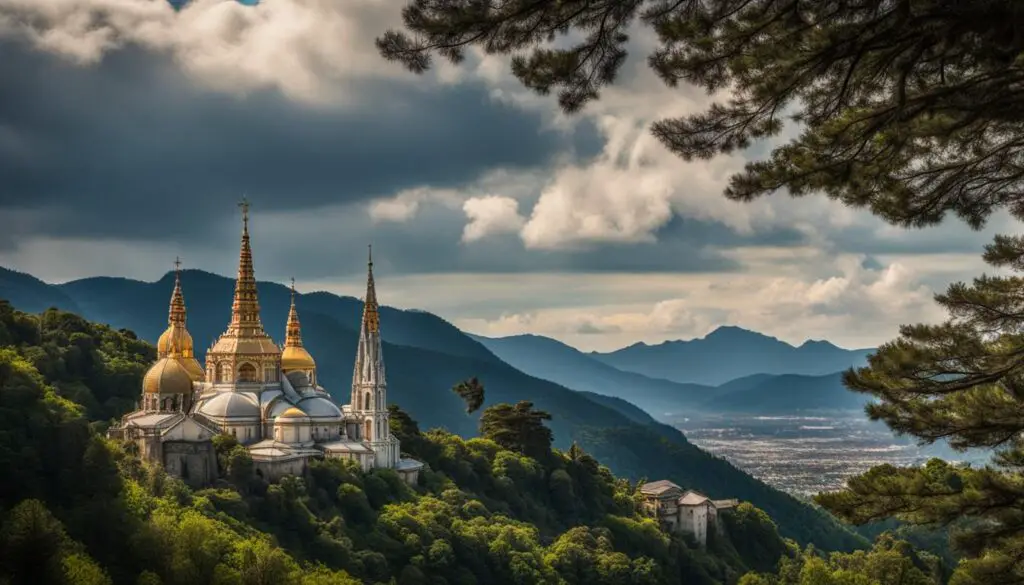
The inclusion of landscapes in religious art during the Renaissance not only enhanced the visual appeal but also expanded the potential for viewer engagement. By juxtaposing religious figures in familiar surroundings, artists allowed viewers to connect with the divine narratives on a personal and relatable level. The importance of landscapes in religious art cannot be understated, as they helped bridge the gap between the spiritual and the earthly, making religious themes accessible to all.
Symbolism and Allegory in Renaissance Christian Iconography
The use of symbolism and allegory was a prominent feature in Renaissance Christian art. Artists employed various symbols and hidden meanings to convey spiritual depth and religious concepts in their works. One of the most recognizable symbols in Renaissance art is the halo, which often appears above the heads of saints. The halo signifies divine enlightenment and holiness, serving to elevate the subjects and emphasize their godly nature.
Another common symbol utilized in Renaissance Christian iconography is the lamb, which symbolizes the sacrificial role of Christ. Artists incorporated the lamb in their works to represent the ultimate act of redemption and the transformative power of faith. Additionally, allegorical narratives were employed to convey deeper meanings and invite contemplation. These narratives used symbols to represent abstract concepts and moral values, allowing viewers to engage in a thoughtful exploration of spiritual matters.
“The halo signifies divine enlightenment and holiness, serving to elevate the subjects and emphasize their godly nature.”
“Artists incorporated the lamb in their works to represent the ultimate act of redemption and the transformative power of faith.”
Table: Religious Symbols in Renaissance Christian Art
| Symbol | Meaning |
|---|---|
| Halo | Divine enlightenment, holiness |
| Lamb | Sacrificial role of Christ |
| Cross | Symbol of Christ’s sacrifice and salvation |
| Anchor | Symbol of hope and steadfast faith |
| Dove | Symbol of the Holy Spirit and peace |
Artists such as Giotto, Fra Angelico, and Albrecht Dürer masterfully employed symbolism and allegory to engage viewers in contemplation and reflection. Through these visual languages, they were able to unlock metaphysical realities and create a gateway for the divine to be experienced by the viewers. The use of symbolism and allegory in Renaissance Christian iconography added depth and layers of meaning to the artworks, inviting viewers to delve into the spiritual and transcendental aspects of faith.
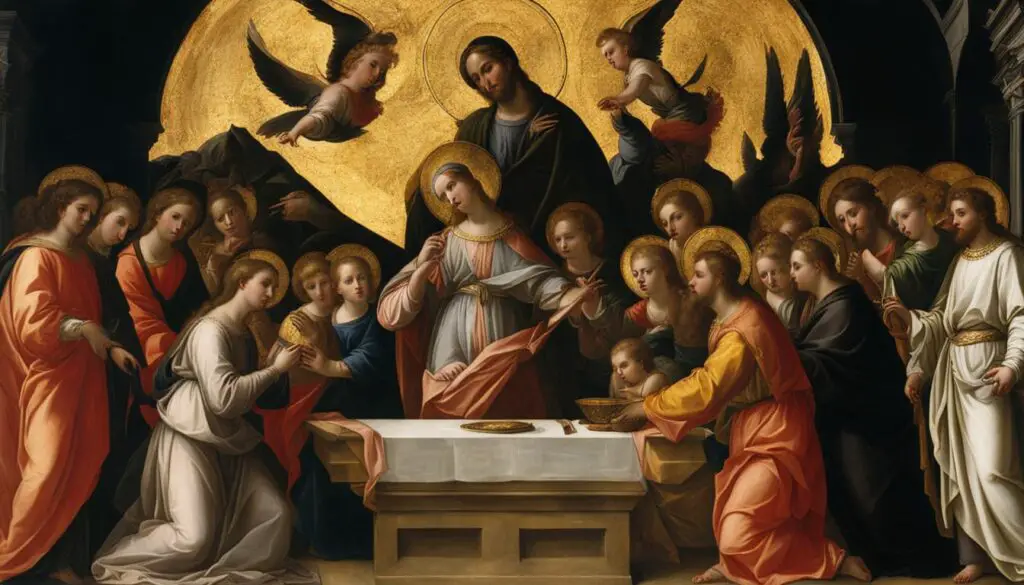
The Influence of the Reformation on Renaissance Art
The Reformation movement had a profound impact on Renaissance art, shaping its themes and subjects. As the Reformation challenged the authority of the Catholic Church, artists began to explore new artistic expressions that reflected the changing beliefs and perspectives of the time. This diversification of religious subjects in Renaissance artwork led to a richer and more diverse artistic landscape.
One of the significant changes brought about by the Reformation was the depiction of religious figures and narratives. Artists moved away from the traditional and idealized representations of saints and biblical stories, opting for more realistic and relatable portrayals. This shift allowed viewers to connect with the subjects on a more personal level, making the religious narratives more accessible and relevant to everyday life.
Furthermore, the Reformation encouraged artists to explore new ways of expressing religious devotion. While the Catholic Church had been the primary patron of the arts, the Reformation shifted the focus to individual and local communities. Artists began creating artwork for Protestant churches and private patrons, resulting in a wider range of styles and interpretations. The influence of the Reformation on Renaissance art opened up new avenues for artistic expression and allowed for a greater diversity of religious subjects in artworks.
| Aspect | Impact |
|---|---|
| New Subjects | The Reformation led to the exploration of new religious subjects in Renaissance art, reflecting the changing beliefs and perspectives of the time. |
| Realism | Artists moved away from idealized representations and depicted religious figures in a more realistic and relatable manner, allowing for a deeper connection with the viewers. |
| Artistic Expression | The Reformation encouraged artists to explore new ways of expressing religious devotion, resulting in a wider range of artistic styles and interpretations. |
The influence of the Reformation on Renaissance art was a testament to the power of religious beliefs in shaping cultural and artistic movements. Through the diversification of religious subjects and the exploration of new artistic expressions, the Reformation brought about a significant transformation in Renaissance art. The impact of the Reformation continues to resonate in the artistic landscape, reminding us of the ever-evolving nature of artistic expression and the enduring influence of religious themes in art.
The Impact of Renaissance Art on Society
Renaissance art had a profound impact on society, shaping cultural and intellectual movements of the time. The religious influence in Renaissance paintings and artwork inspired awe and respect, creating a sense of devotion and reverence among the public. Churches served as patrons of the arts, commissioning paintings and sculptures to inspire greater religious fervor and reflect their devotion to religion. Renaissance art made biblical narratives and religious themes accessible to the masses, allowing even those who could not read the scriptures to connect with and visualize the stories. The technical advancements and artistic innovations of the Renaissance, combined with religious themes, created a visual testament to divine stories and inspired a deeper understanding and appreciation of religion.
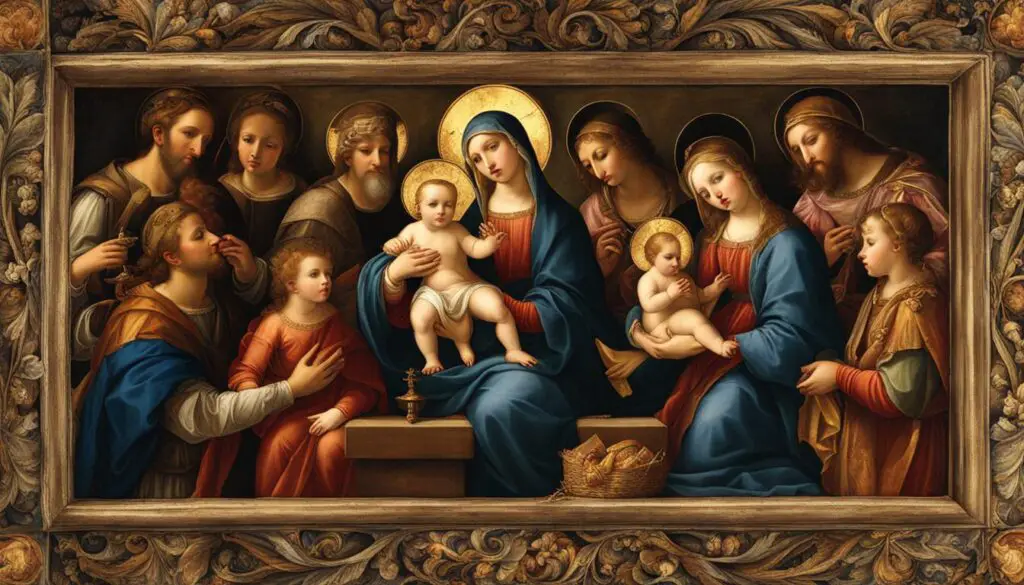
The impact of Renaissance art extended beyond religious devotion, influencing various aspects of society. The beauty and sophistication of Renaissance artwork inspired admiration and sparked a renewed interest in the arts. The intricate details, vivid colors, and realistic portrayals showcased the skill and talent of the artists, setting new standards for artistic excellence. The popularity of Renaissance art led to the establishment of art academies and the professionalization of artists. Art became a valued commodity, sought after by collectors and patrons, elevating the status of artists in society. The enduring legacy of Renaissance art can be seen in the continued appreciation and admiration for its masterpieces, which are still celebrated and studied today.
In addition to its artistic and cultural impact, Renaissance art also played a role in shaping societal values and attitudes. The humanistic ideals embraced during the Renaissance emphasized the importance of human experience and individuality. This shift in thinking was reflected in the artwork of the time, with artists exploring new subject matters, including secular themes and portraits of influential figures. Renaissance art celebrated the human form, with artists depicting the beauty and complexity of the human body. This celebration of humanity and individuality helped to shape a more human-centered worldview, challenging the traditional focus on divine authority and hierarchical structures. The influence of Renaissance art on societal values can still be seen today, as it continues to inspire creativity, individual expression, and a celebration of human potential.
The Enduring Legacy of Religious Influence in Renaissance Art
The influence of religion on Renaissance art was profound, shaping its themes, symbolism, and subjects. Renaissance artists drew inspiration from religious narratives and figures, using their skills to create masterpieces that evoked powerful emotions and deepened viewers’ connections with spirituality. The religious influence in Renaissance paintings continues to resonate in the artistic and cultural landscape, leaving an enduring legacy that has shaped contemporary artistic expressions.
One of the most significant aspects of religious influence in Renaissance art was the portrayal of religious subjects. Artists depicted biblical stories, saints, and religious figures, bringing them to life through their meticulous attention to detail and artistic techniques. The paintings served as visual testimonies to the divine, inspiring awe and reverence among the public. The enduring popularity of these religious subjects can be seen in the numerous reproductions and references to Renaissance artwork in modern culture.
“The religious influence in Renaissance art serves as a testament to the power of faith in shaping cultural and artistic movements.”
Another key element of religious influence in Renaissance art was the use of symbolism. Artists employed symbols to convey hidden meanings and spiritual depths in their works. The halo, for example, symbolized holiness and divine enlightenment, enhancing the significance of the depicted religious figures. Symbolism and allegory allowed artists to create a visual language that resonated with viewers, inviting them to reflect on spiritual and religious themes. The incorporation of religious symbols in Renaissance art added layers of meaning and invited contemplation.
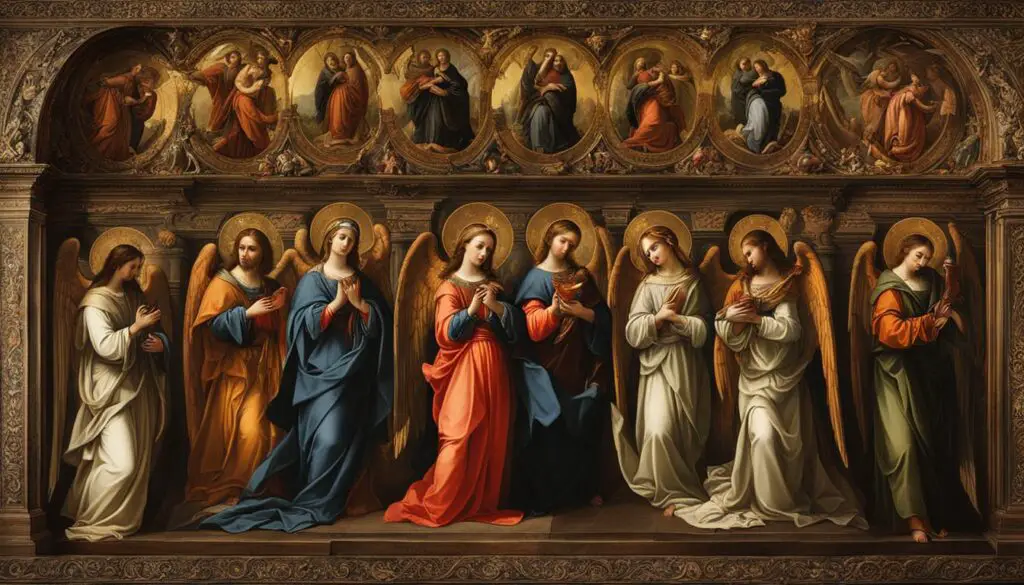
The enduring legacy of religious influence in Renaissance art extends beyond the artwork itself. It has shaped the cultural and artistic heritage of subsequent generations, inspiring artists and viewers alike. The themes, symbolism, and use of religious subjects continue to be explored in contemporary artistic expressions, demonstrating the lasting impact of religious influence on Renaissance art. The ability of this art to connect individuals with spirituality and provoke contemplation underscores its enduring significance in the artistic and cultural world.
Conclusion
The influence of religion on Renaissance art was profound, shaping its themes, symbolism, and subjects. During this period of cultural, intellectual, and scientific advancements, religion played a central role in inspiring and guiding artistic expressions. The exploration of religious themes in Renaissance art allowed artists to bring biblical narratives to life, evoking devotion and inspiring a deeper connection with spirituality.
Religious symbolism and iconography added spiritual depth and hidden meanings to Renaissance artworks. Artists used symbols such as halos, lambs, and allegorical narratives to convey profound theological concepts and engage viewers in contemplation. The depiction of religious figures, particularly Madonna and Christ, created a focal point for prayer, reflection, and spiritual devotion.
The influence of the Reformation movement further diversified the subjects and perspectives in Renaissance art. The artists were inspired by the evolving religious beliefs and the challenge to the authority of the Catholic Church. This resulted in a broader exploration of religious subjects, reflecting the changing theological landscape of the time.
The enduring legacy of religious influence in Renaissance art is evident in its continued resonance and impact on the artistic world. The themes, symbolism, and narratives explored during this period continue to inspire contemporary artists and shape artistic expressions today. The religious influence in Renaissance art serves as a testament to the power of faith in shaping cultural and artistic movements throughout history.
FAQ
What was the role of religion in Renaissance paintings?
Religion played a profound influence on Renaissance paintings, shaping themes, symbolism, and subjects. Artists used their skills to render biblical stories and capture the essence of religious figures, conveying theological messages through their depictions.
How did religious symbolism impact Renaissance art?
Religious symbolism played a significant role in Renaissance art. Artists used symbols to convey hidden meanings and spiritual depths in their works. The halo symbolized divine enlightenment and holiness, while allegory represented deeper concepts.
What was the significance of Madonna and Christ in Renaissance art?
The representation of Madonna and Christ was a prominent theme in Renaissance art. Artists portrayed Madonna as a loving and tender mother, evoking devotion and inspiring religious feelings. These paintings served as centrepieces for prayers and reflections.
How did religious portraiture contribute to Renaissance art?
Religious portraiture captured the spiritual power and holiness of saints. Artists paid attention to detail, depicting subjects in a naturalistic manner to relate to viewers and highlight the relevance of religious figures in everyday life.
What was the importance of landscape in religious art?
Landscape settings played an important role in religious art during the Renaissance. Artists used relatable settings to create a stronger connection between the observer and the religious figures, allowing viewers to envision themselves in the scenes.
What role did symbolism and allegory play in Renaissance Christian iconography?
Symbolism and allegory were key elements of Renaissance Christian iconography. Artists used symbols and hidden meanings to convey spiritual depth and religious concepts in their works, unlocking metaphysical realities and creating gateways for the divine.
How did the Reformation influence Renaissance art?
The Reformation sparked a shift in artistic themes and subjects, challenging the authority of the Catholic Church. Artists began to explore new artistic expressions influenced by the Protestant faith and the renewal of theological principles.
What impact did Renaissance art have on society?
Renaissance art shaped cultural and intellectual movements, inspiring awe and devotion among the public. Churches served as patrons of the arts, commissioning paintings and sculptures to reflect their devotion and make religious narratives accessible to all.
What is the enduring legacy of religious influence in Renaissance art?
The religious influence in Renaissance art has had a lasting impact on the artistic and cultural landscape. The themes, symbolism, and subjects explored during this period continue to resonate in art history and shape contemporary artistic expressions.
Is religion an important aspect of Renaissance art?
Yes, religion played a significant role in Renaissance art, shaping its themes, subjects, and symbolism. The religious influence brought biblical narratives to life and inspired greater devotion and reverence among the public.
Source Links
- https://www.history.com/news/renaissance-influence-reformation-humanism
- https://medium.com/@ameerasara2000/exploring-christian-iconography-in-the-renaissance-a-divine-renaissance-of-art-ef151c773967
- https://artsandculture.google.com/usergallery/religious-art-throughout-the-renaissance/1wISpDWs4ZhBJA


